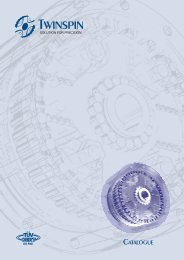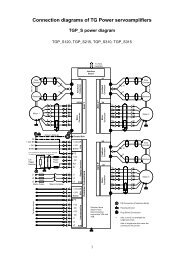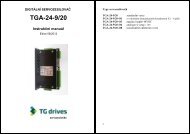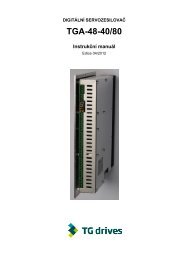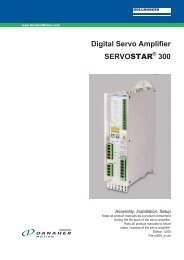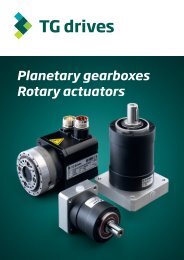Table of Contents - TG Drives
Table of Contents - TG Drives
Table of Contents - TG Drives
Create successful ePaper yourself
Turn your PDF publications into a flip-book with our unique Google optimized e-Paper software.
68<br />
Pg, Pr<strong>of</strong>ile generator<br />
PG, PROFILE GENERATOR<br />
Group Group<br />
No<br />
Description<br />
EXTENDED REGISTER GROUPS<br />
Pg 4 Pr<strong>of</strong>ile Generator. The pr<strong>of</strong>ile generator calculates the<br />
velocity pr<strong>of</strong>iles used for trapezoidal movements.<br />
GENERAL<br />
The Pr<strong>of</strong>ile generator (Pg) group controls the basic motion function. Any movement<br />
can be defined as segments <strong>of</strong> acceleration, constant speed and deceleration and<br />
the Pg function accomplishes this.<br />
This function produces so-called Trapezoidal pr<strong>of</strong>iles which are movements with<br />
three phases, acceleration, constant speed and deceleration. The target position is<br />
reached with the speed = 0.<br />
When the Connect instruction is used on this group and for instance the regulator,<br />
the values are taken from the same servo cycle. The old DMC 2 showed values one<br />
servo cycle ahead for the Pr<strong>of</strong>ile group.<br />
FUNCTION<br />
Pg.APos<br />
Pg.ASpeed<br />
Pg.Acc<br />
Pg.Ret<br />
Pg.Decel<br />
Pg.RSlope<br />
Pg.PosSpeed<br />
Pg.Rdy<br />
The pr<strong>of</strong>ile generator outputs command values for speed and<br />
position with 1 ms update rate. These values are used by the<br />
regulator as input values. The outputs are PG.APos and Pg.Aspeed<br />
where PG.APos is the integrated value <strong>of</strong> Pg.ASpeed.<br />
To get any output, the Pg.Acc must be set to some value > 0 and<br />
that value will be used as the acceleration limit.<br />
Pg.Ret (or. Decel) is used only to determine when it is time to start<br />
the deceleration phase and from that point on the actual deceleration<br />
is calculated each ms so that the speed will be zero when the<br />
position target is reached.<br />
The deceleration phase can be smoothed by setting the value <strong>of</strong><br />
Pg.RSlope > 0. This will provide an exponential velocity change<br />
instead <strong>of</strong> a linear one during deceleration. When Pg.RSlope > 0 the<br />
deceleration will initially be higher than the value stated in the<br />
parameter Pg.Ret.<br />
The Pg.PosSpeed determines the top speed <strong>of</strong> the pr<strong>of</strong>iles.<br />
The bit register Pg.Rdy reports when the pr<strong>of</strong>ile is finished.<br />
The pr<strong>of</strong>ile generator can also take values from an array specifying segments <strong>of</strong><br />
acceleration and duration time. This makes it possible to define customized<br />
pr<strong>of</strong>iles. In this case none <strong>of</strong> the other parameters are involved. The array can<br />
have up to 1000 segments.<br />
RELATED ITEMS<br />
Pos Abs<br />
Pos Rel<br />
Move to the absolute position .<br />
Move to the absolute position ( + Pg.Apos)<br />
User's Manual 5.1 Inmotion Technologies AB<br />
Doc. No.9032 0027 01 (B), Rev. 11.07.2001



